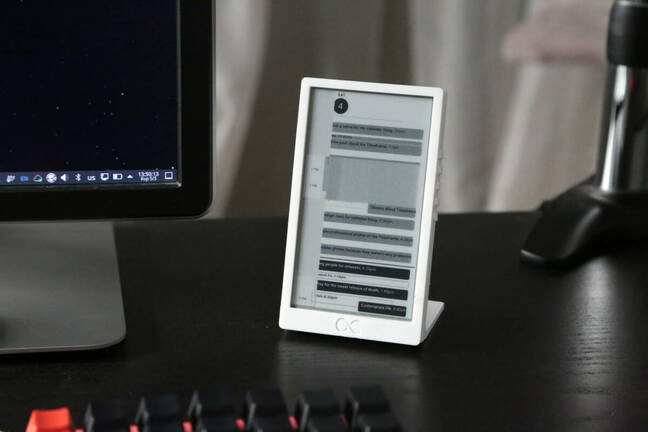Cop A Load Of This DIY E-ink Calendar To Help Plan Those Projects You'll Never Finish
There's more to inexpensive single-board computers than the Raspberry Pi. Some DIY projects are just for fun, but others also have immediate practical value – like a low-power, self-updating desk calendar.
Cheap mass-market hardware is causing something of a golden age of experimental do-it-yourself computer building. It must be said, though, some of the projects are cool but not much obvious use. There are only so many Raspberry Pi-based weather stations one can use… which is why Stavros Korokithakis's project, Timeframe, stood out to us.
It doesn't use a Raspberry Pi, it's self-contained, and when we read his wonderful, modest write-up of how he made it, rather than dazzling us with programming expertise, he left us wondering if we could make one too. Which, for our money, is how this sort of project should work.
Korokithakis seems to be a very versatile chap: he's a pretty good photographer and also has a way with words. For instance, while he could have written some C++ to parse Google Calendar and render the results, that sounded hard (it does to us too). But…
The Reg FOSS desk finds this highly relatable on multiple counts.
The Timeframe – it's a clever name too – is a 3D-printed plastic frame holding a Lilygo T5, which is a 4.7-inch (11cm) e-paper touchscreen, together with an ESP32 processor, a little RAM and flash, and a holder for a standard 18650 rechargeable battery, which can be bought online from the usual suspects.
- openSUSE finds an elegant solution to x86-64 version support
- A new version of APT is coming to Debian 12
- AmigaOS 3.2.2 released for those feeling nostalgic
- How to get the latest Linux kernel on your Ubuntu box
We feel very confident that we can't beat his own write-up of how he put it all together. It's well worth reading.
It's not the first of its kind we've seen. SystemSix is a genuinely beautiful device, and "a kind of love-letter to my first Macintosh." The Portal e-ink calendar is also geekily cool. As Portal on its own represents a full 50 percent of the video games this vulture has bought in the last decade, we are not immune to its charms. You can also probably guess what both of these devices are powered by.
We had only previously encountered Lilygo in the context of the VGA32, a tiny self-contained computer with PS/2 keyboard and mouse ports and a VGA output, which sells for about a tenner on the big Chinese sites. Using the FabGL programming library, this can emulate various 8-bit and even 16-bit computers, enabling it to run the now open source CP/M operating system. This particular vulture feels no great need, though, as he still owns an Amstrad PCW. ®
From Chip War To Cloud War: The Next Frontier In Global Tech Competition
The global chip war, characterized by intense competition among nations and corporations for supremacy in semiconductor ... Read more
The High Stakes Of Tech Regulation: Security Risks And Market Dynamics
The influence of tech giants in the global economy continues to grow, raising crucial questions about how to balance sec... Read more
The Tyranny Of Instagram Interiors: Why It's Time To Break Free From Algorithm-Driven Aesthetics
Instagram has become a dominant force in shaping interior design trends, offering a seemingly endless stream of inspirat... Read more
The Data Crunch In AI: Strategies For Sustainability
Exploring solutions to the imminent exhaustion of internet data for AI training.As the artificial intelligence (AI) indu... Read more
Google Abandons Four-Year Effort To Remove Cookies From Chrome Browser
After four years of dedicated effort, Google has decided to abandon its plan to remove third-party cookies from its Chro... Read more
LinkedIn Embraces AI And Gamification To Drive User Engagement And Revenue
In an effort to tackle slowing revenue growth and enhance user engagement, LinkedIn is turning to artificial intelligenc... Read more


